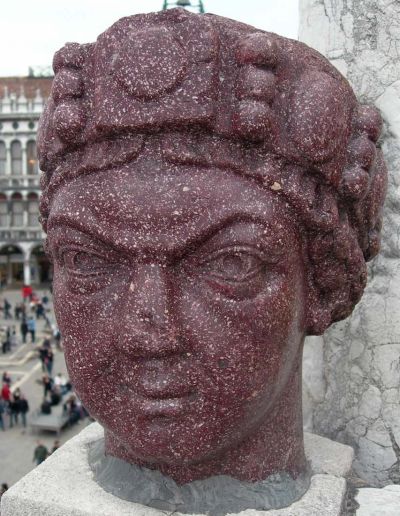
Carmagnola is a porphry stone head of an Eastern Roman Emperor which was taken from Constantinople in the aftermath of the destruction and desecration of Constantinople by the French and Venetians during the Fourth Crusade in 1204. It is not possible to conclusively 100% identify this statue, as it is not inscribed nor do we have a written source identifying the Emperor which it depicts. However, one modern guess is the Emperor Justinian. I for one cannot object to that hypothesis, it definitely gives off Justinian vibes to me. But there are scholars who believe it is older than that. It is true that statue-making became less common by the time of Justinian.
It is described in Oxford’s Last Statues of Antiquity:
“The head is of a beardless man, with short hair left as a rough surface, who wears a diadem. His eyes have drilled pupils, probably inlaid in origin, with crisply cut eyelids under arching brows and moulded forehead masses. The nose has an extremely flat profile. The head is slightly asymmetrical, suggesting that it was intended to be seen from the left of frontality, and would have been fixed into a bust or full-length statue. Except for the central jewel of the diadem, the state of preservation is good. Traces of paint are visible on the hair and the eyes, but it is not clear whether they date from the original creation of the work.”
WHO’S HEAD IS IT?:
I will present you with the scholarly take from Oxford:
“A head with a diadem, carved in imperial porphyry, is certainly imperial. The flattened nose led several scholars to identify the head as the portrait of Justinian II (685-695 and 705-711), deposed in 695 and humiliated by cutting off his nose. However, the flattened profile of the nose is, more prosaically, a hint of the fact that it was re-polished for reuse after damage at an early date. More recently the head has been dated to the 4th century and attributed to the enthroned statues of Constantine’s sons “in the region of the so-called gate of Philadelphion” described by the Parastaseis (chap. 58) and surviving into the early 15th century, which were known as the ‘True Judges’. This porphyry group was among the crusaders’ targets in 1204.”

“Stylistically the closest parallels are of the late 5th/early 6th centuries: the so-called ‘Barletta colossus,’ perhaps representing Leo I (457-74) or Zeno (474-91); Justinian’s mosaic image in the basilica of San Vitale at Ravenna; and the gold medallion, formerly in the Louvre and probably struck in 530s to commemorate some imperial victory.”
It is clearly a 4th-6th century, but it seems the ‘who’ may never be answered, unfortunately.
LOCATION AND VENETIAN HISTORY:

This is a description from the University of Oxford’s Last Statues of Antiquity – “The porphyry head is set into the balustrade at the south-western corner of the exterior balcony of the basilica of San Marco in Venice, near the famous bronze horses and not far off a vertical line above the group of the Tetrarchs, embedded in the corner of the wall of the church treasury. All these spolia were almost certainly looted by the Venetians in Constantinople during the Fourth Crusade of 1204. In late medieval and renaissance Venice the head was popularly known as ‘Carmagnola’ after the nickname of the comandante di ventura Francesco Bussone, who was accused of being a traitor and beheaded in the “Piazzetta di San Marco” on May 5, 1432. The portrait soon developed a life of its own, inspiring legends and moralizing tales of greed, conspiracy and murder. As late as 1611 the Venetians were still using the porphyry column drum (“Colonna del Bando”) below the ‘Carmagnola’ to exhibit severed heads of traitors”
SOURCES:
https://ferrebeekeeper.wordpress.com/2021/03/10/la-carmagnola/ – for images
http://laststatues.classics.ox.ac.uk/database/discussion.php?id=826 for information

